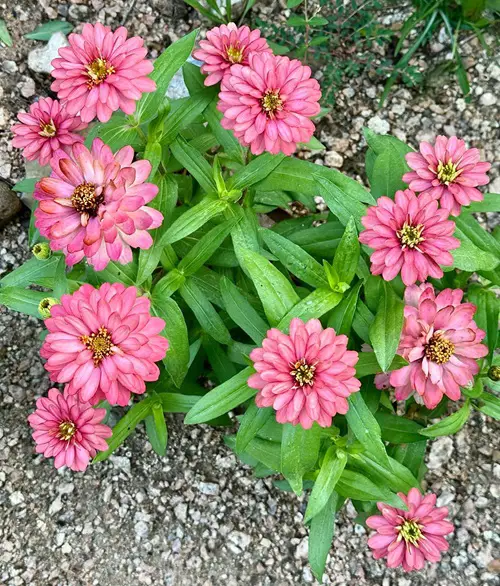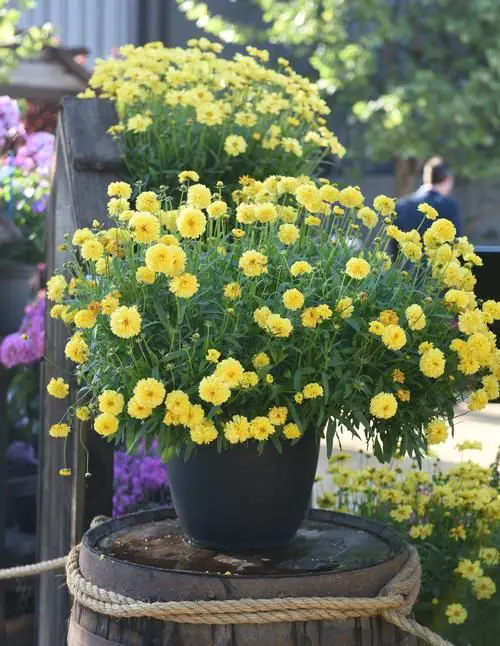If you love chrysanthemums and want to add more flowers that look like mums to your garden, these are the best options.
Chrysanthemums, or mums, are beautiful flowers that grow in multi-layered petal forms. If you adore these blooms and want to add some mum-look-alike varieties, then this post is for you. These might look visually similar to mums, but they have their own uniqueness that sets them apart.
Flowers That Look Like Mums
1. Dahlias
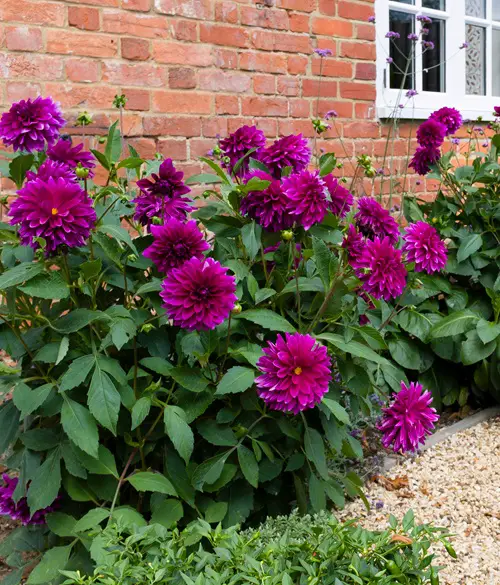
Botanical Name: Dahlia spp.
Regardless of size, you will find dahlia varieties like ‘dahlia ball’ and ‘dahlia pompon,’ like mirror images of mums. These come in white, yellow, red, or purple hues, and it won’t be wrong to dub them as the closest to any other flower on the list.
What sets dahlias apart from mums is that dahlias are tuberous plants, and you can dig them up and replant them each year. If you want thriving dahlias, ensure good fertilizer doses and proper watering techniques. A balanced fertilizer with less nitrogen will do wonders for this flower.
2. Asters
Botanical Name: Aster spp.
These flowers can be your perfect pollinator magnets and have round star-shaped blooms, just like mums. There is more to Aster flowers, including their symbolism of love and patience, which makes it an addition with a message.
Mums and asters are not just visually similar, but they both have the same soil and light requirement, which means you can grow them next to each other and enjoy their eye-catching beauty.
3. Zinnias
Botanical Name: Zinnia spp.
Zinnias is an answer to having a mums-like flower, which is easier to care for and suits the busy gardener in you. These are drought-tolerant in nature, and you can keep them in some neglect, too. The double-flowered look makes them look similar to mums, but unlike mums, zinnias are annuals and can thrive in dry and hot climates.
These flowers have basic care requirements, which include full sunlight and nutrient-rich, well-draining soil.
4. Marigolds

Botanical Name: Tagetes spp.
The rounded blooms of double-flowered marigolds look like the mini versions of mums. Gardeners love Marigols for their pest-repellent nature, and you can easily plant them among your vegetables to keep the pests away.
Another similarity exists but with a twist. Both mums and marigolds are fragrant flowers, but marigolds have an earthy fragrance perfect for repelling pests. Meanwhile, mums have a more pleasant and mild fruity fragrance that is soothing to your senses.
5. Coreopsis
Botanical Name: Coreopsis spp.
Also known as tickseed, coreopsis has many varieties that resemble the round blooms of mums. The best thing about these flowers is that they can be grown in poor soils, where most plants, including mums, struggle.
Unlike mums, coreopsis becomes sparse in late summer and fall, but they are most likely to resemble mums in their peak bloom season in early summer. If you want long-lasting blooms that are beautiful and attract butterflies, this is the best choice.
6. Carnations
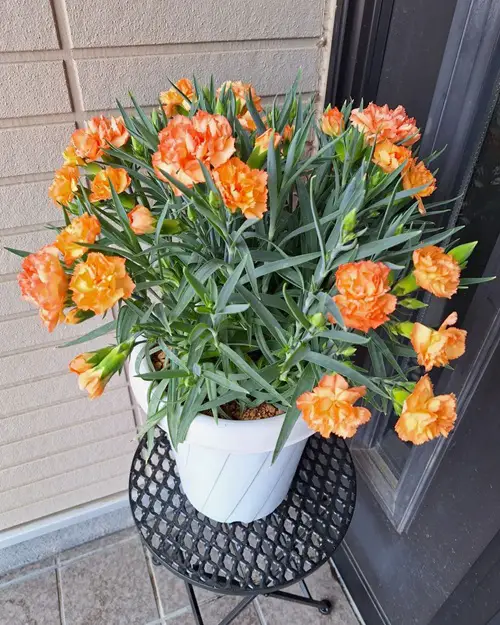
Botanical Name: Dianthus caryophyllus
Carnations have been cultivated for two thousand years, and their clove-like scent sets them apart from mums. However, if we talk about similarity, the double-flowered carnations have a dense, rounded appearance that makes them look similar to mums.
These flowers do best in full sun but can be fine with some partial shade, which makes them suitable for your versatile locations. Carnations are best for busy gardeners due to their drought-tolerant nature.
7. Nippon Daisy

Botanical Name: Nipponanthemum nipponicum
This flower belongs to Japan and is also known as the Montauk daisy. Because of its bright white blooms, it is often used for decoration. It grows about 1 to 2 feet tall and wide (30 to 60 cm).
It needs care similar to Shasta daisies and coreopsis. Only a little trimming is required in order to keep it blooming from fall to summer.
8. Pincushions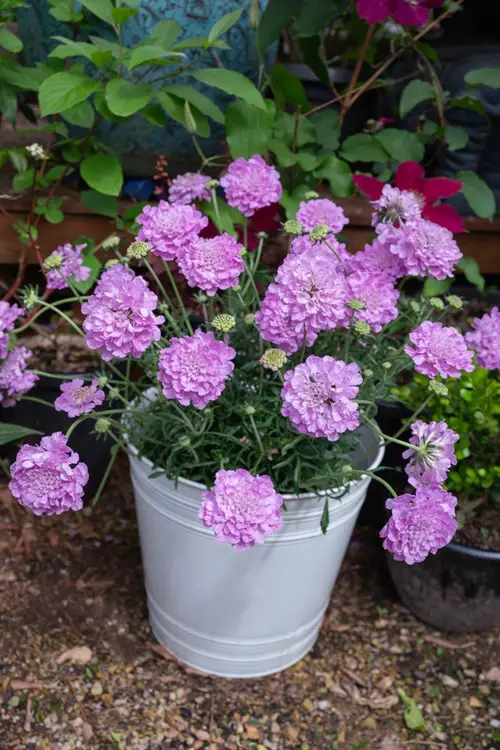
Botanical Name: Scabiosa
This short-living perennial appears in many shades. It has a button-like shape with petals that flutter in the wind. In favorable growing conditions, flowers can last from spring to the first frost.
Pincushion flowers are non-toxic to humans and animals. They prefer moderate temperatures and well-draining soil.
9. Golden Marguerite
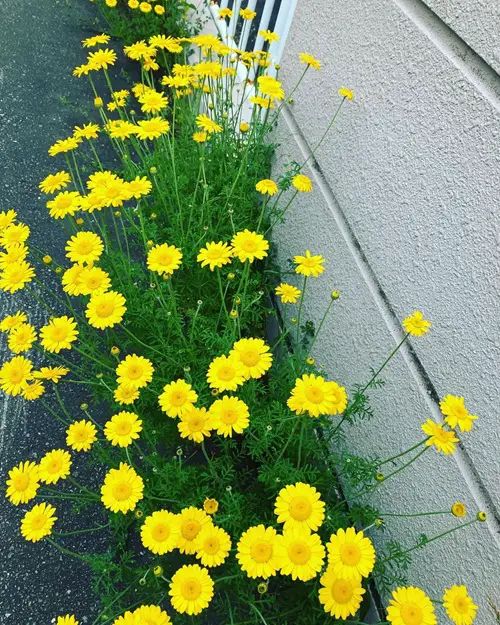
Botanical Name: Anthemis tinctoria
Also known as yellow chamomile or ox-eye chamomile, this flower looks like a chrysanthemum with its bright yellow petals and golden centers. Despite their fancy appearance, golden marguerite is easy to grow.
They love full sun and can handle some shade and drought but prefer cool and slightly humid conditions and grow best in USDA Zones 3-8.



